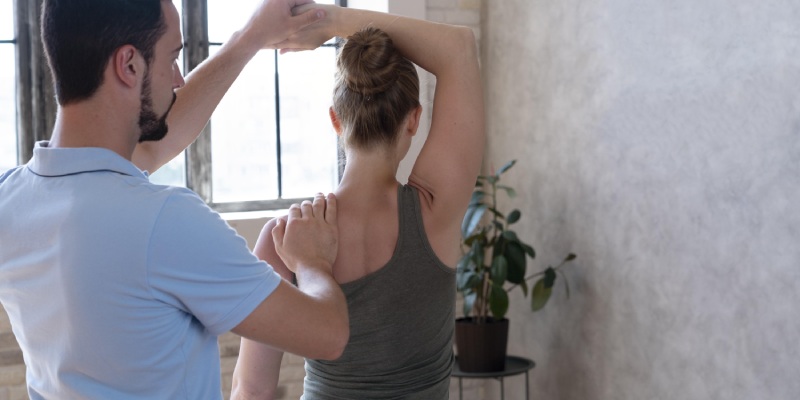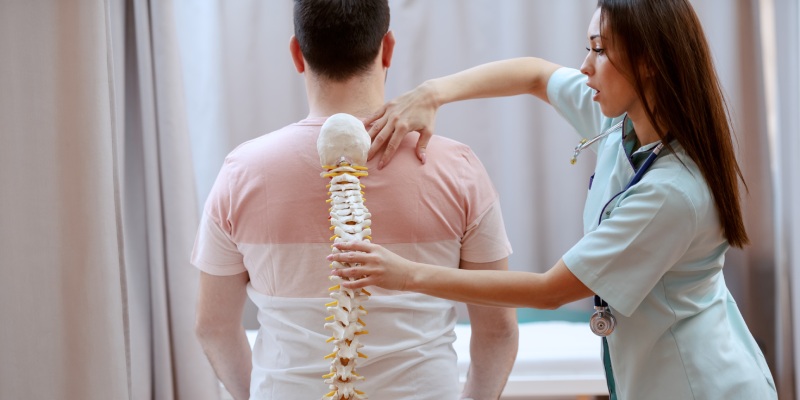
Scoliosis, characterized by an abnormal sideways curvature of the spine, can significantly impact one’s well-being. While conventional treatments exist, Ayurveda, the ancient Indian system of medicine, offers a holistic approach to managing scoliosis. In this article, we will guide you on powerful Ayurvedic Treatment for Scoliosis. We will also explore the signs, causes, and types of scoliosis, shedding light on how Ayurveda can play a vital role in alleviating symptoms and promoting overall health.
Understanding Scoliosis
Scoliosis, a condition characterized by an abnormal curvature of the spine, can be a source of discomfort and pain for many individuals.
Scoliosis affects millions worldwide, causing physical and emotional challenges. Conventional treatments often involve bracing or surgery, but Ayurveda presents an alternative path to spinal alignment. Let’s explore the ancient wisdom that Ayurveda brings to the table.
Signs & Symptoms of Scoliosis
Understanding the signs and symptoms is the first step in addressing scoliosis:
- Uneven Shoulders: One shoulder blade appears higher or more prominent than the other.
- Uneven Waist: A noticeable asymmetry in the waistline, with one side higher or more defined.
- Asymmetrical Hips: Hips appear uneven, with one side higher or more pronounced than the other.
- Spinal Curve: A sideways curvature of the spine, forming an “S” or “C” shape, often visible when bending forward.
- Tilted Head: The head may not align with the centre of the pelvis when viewed from behind, indicating a potential spinal deviation.
- Uneven Leg Length: One leg appears longer than the other, contributing to an uneven stance.
- Back Pain: Chronic or persistent back pain, particularly in areas affected by abnormal spinal curvature.
- Limited Mobility: Difficulty in performing certain movements due to the restrictions imposed by the spinal curvature.
Causes of Scoliosis

Identifying the underlying causes of scoliosis is crucial for tailored treatment approaches:
- Neuromuscular Conditions: Muscle issues from conditions like cerebral palsy.
- Birth Defects: Abnormal spinal structures present at birth.
- Spine Injuries: Trauma causing spinal curvature.
- Idiopathic: Unknown cause, often genetic, appearing in adolescence.
Types of Scoliosis
Understanding the different types of scoliosis guides individualized assessment and treatment:
- Congenital Scoliosis: Present at birth due to spinal abnormalities.
- Idiopathic Scoliosis: Most common, with no known cause, categorized by age.
- Neuromuscular Scoliosis: Caused by muscle issues from conditions like cerebral palsy.
- Degenerative Scoliosis: Appears in older age due to spine degeneration.
- Syndromic Scoliosis: Associated with genetic syndromes.
Complications
Untreated or severe scoliosis can lead to:
- Persistent Back Pain: Chronic discomfort in areas affected by the unusual spine shape, impacting daily life.
- Breathing Challenges: Diminished lung space from pronounced curvature, resulting in breathlessness.
- Heart and Organ Strain: Affected positioning of organs, potentially causing reduced cardiac function.
- Digestive Discomfort: Compression of abdominal organs causing digestive problems.
- Potential Spinal Cord Issues: Rare instances of significant curvature causing spinal cord damage or nerve compression.
- Emotional Impact: Negative psychological effects, including decreased confidence and social anxiety, due to visible physical changes.
Ayurvedic Treatment for Scoliosis

Ayurvedic practitioners use a holistic approach to diagnose scoliosis. By identifying the underlying imbalances in doshas, they tailor treatments to address the root cause rather than just the symptoms. This personalized diagnosis sets the foundation for effective Ayurvedic interventions.
Let’s explore the powerfull Ayurvedic Treatment for Scoliosis:
Herbal Remedies in Ayurveda for Scoliosis
Ayurveda, with its holistic approach, offers a treasure trove of herbal remedies to address issues related to spinal alignment. Let’s explore some potent herbs that have been traditionally used to alleviate discomfort and promote overall spinal health.
- Ashwagandha (Withania somnifera): Known as the “Indian Ginseng,” Ashwagandha’s anti-inflammatory properties make it a go-to herb for reducing pain and inflammation associated with spinal issues.
- Guggul (Commiphora wightii): Guggul, with its ability to improve blood circulation, contributes to maintaining the integrity of the vertebral column, supporting overall spinal health.
- Turmeric (Curcuma longa): The golden spice turmeric contains curcumin, which has potent anti-inflammatory effects, offering relief from discomfort related to spinal alignment issues.
- Boswellia (Boswellia serrata): Boswellia resin, renowned for its anti-arthritic properties, supports joint flexibility, easing movement and promoting comfort in the spine.
- Triphala: Triphala, a blend of three fruits, acts as a natural detoxifier, eliminating toxins and contributing to the overall health of the spine.
- Licorice (Glycyrrhiza glabra): With anti-inflammatory and analgesic properties, liquorice becomes a valuable herb in managing discomfort associated with spinal alignment.
- Bala (Sida cordifolia): Bala, known for its muscle-strengthening properties, aids in improving muscle tone around the spine, providing essential support.
- Ginger (Zingiber officinale): Ginger, with its anti-inflammatory and analgesic effects, can be beneficial for individuals experiencing discomfort related to spinal alignment.
Dietary Recommendations for Scoliosis
A balanced and spine-friendly diet plays a crucial role in managing issues related to spinal alignment. Let’s explore dietary recommendations that contribute to overall spinal health and alleviate associated discomfort.
- Anti-Inflammatory Foods: Including foods rich in omega-3 fatty acids can significantly reduce inflammation, providing relief from discomfort related to spinal alignment.
- Calcium-Rich Foods: Dairy products, leafy greens, and fortified plant-based milk support bone health, which is crucial for maintaining the integrity of the vertebral column.
- Vitamin D Sources: Adequate exposure to sunlight and inclusion of vitamin D-rich foods enhance calcium absorption, promoting overall spinal health.
- Avoid Processed Foods: Limiting processed and sugary foods helps prevent the exacerbation of discomfort associated with spinal alignment.
- Magnesium-Rich Foods: Nuts, seeds, and whole grains provide essential magnesium, supporting muscle function and alleviating muscle spasms around the spine.
- Protein for Muscle Health: Lean protein sources contribute to muscle strength, offering vital support to the muscles around the spine.
- Hydration: Proper hydration is essential for overall health, maintaining the elasticity of spinal discs and preventing stiffness.
Lifestyle Modifications for Scoliosis
Beyond herbal remedies and dietary adjustments, certain lifestyle modifications play a pivotal role in promoting spinal health. Let’s explore lifestyle changes that contribute to enhanced spinal well-being.
- Regular Exercise: Engaging in low-impact exercises that promote flexibility and strengthen core muscles provides crucial support to the spine.
- Maintain Good Posture: Conscious effort towards maintaining good posture, especially during extended periods of sitting or standing, helps alleviate strain on the spine.
- Ergonomic Adjustments: Making ergonomic changes in your workspace, such as adjusting chair height and incorporating lumbar support, creates a spine-friendly environment.
- Weight Management: Maintaining a healthy weight reduces the load on the spine, preventing exacerbation of discomfort related to spinal issues.
- Regular Stretching: Incorporating stretching exercises into daily routines improves flexibility, preventing muscle tightness around the spine.
- Stress Management: Practicing stress-reducing techniques like meditation or deep breathing alleviates muscle tension, positively impacting spinal health.
- Adequate Sleep: Ensuring sufficient restorative sleep is crucial for the body’s healing processes and overall well-being.
Ayurvedic Therapies for Scoliosis

Ayurvedic therapies offer a unique approach to addressing issues related to spinal alignment. Let’s delve into specific Ayurvedic therapies that promote enhanced spinal alignment and alleviate associated discomfort.
- Panchakarma: Panchakarma, a set of detoxification therapies, purifies the body and eliminates toxins, contributing to reduced inflammation and enhanced spinal health.
- Abhyanga (Ayurvedic Massage): Ayurvedic massage with specific herbal oils relaxes muscles, improves circulation, and addresses stiffness and discomfort related to spinal issues.
- Swedana (Herbal Steam Therapy): Herbal steam therapy induces sweating, supporting detoxification and alleviating pain in the spine.
- Kati Basti (Localized Oil Bath): Kati Basti, with warm herbal oil, can be effective in relieving pain and promoting healing in the affected spinal area.
- Janu Basti (Knee Therapy): Janu Basti involves creating a reservoir of warm herbal oil around the knee, indirectly benefiting the surrounding spinal areas.
- Nasya (Nasal Administration of Medication): Nasya, the administration of herbal oils or powders through the nasal passages, aims to balance doshas and promote overall well-being, indirectly impacting spinal health.
Conclusion
Ayurvedic treatment for scoliosis offers a holistic approach to managing symptoms and improving overall health. While it may not provide a complete cure, the integration of Ayurvedic practices with conventional medical care can significantly enhance the well-being of individuals with scoliosis.
FAQs
Can Ayurvedic treatment completely cure scoliosis?
Ayurvedic treatment aims to manage and alleviate symptoms; however, a complete cure may vary based on individual cases.
How long does it take to see results with Ayurvedic scoliosis treatment?
Results vary, and factors such as severity, adherence to treatment, and individual differences play a role. Patience is key.
Can Ayurveda be used in conjunction with conventional medical treatments for scoliosis?
Yes, Ayurveda can complement conventional treatments, providing a holistic approach to scoliosis management.
Are there specific dietary restrictions in Ayurvedic scoliosis treatment?
Ayurvedic recommendations may include dietary modifications; however, personalized guidance from an Ayurvedic practitioner is crucial.
Is Ayurvedic scoliosis treatment suitable for all age groups?
Ayurvedic treatment can be adapted for different age groups, with personalized approaches based on individual needs and conditions.




